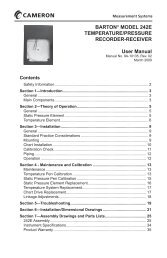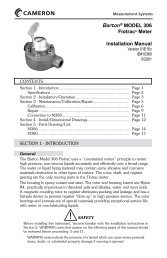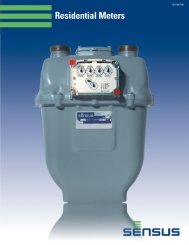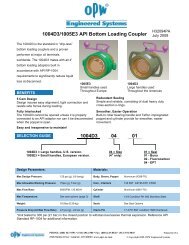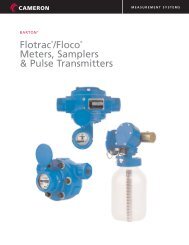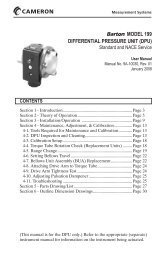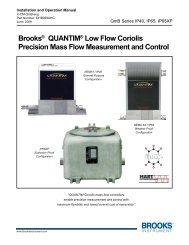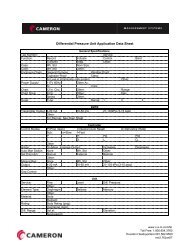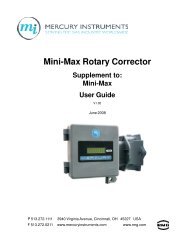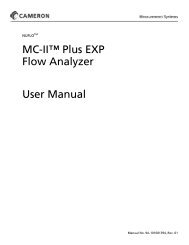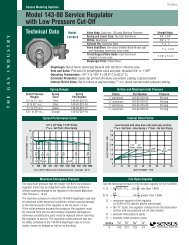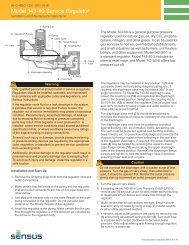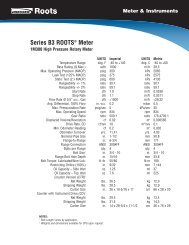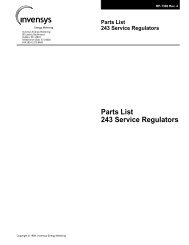Dresser Roots Model 5 Prover Manual - The Meter and Valve ...
Dresser Roots Model 5 Prover Manual - The Meter and Valve ...
Dresser Roots Model 5 Prover Manual - The Meter and Valve ...
- No tags were found...
You also want an ePaper? Increase the reach of your titles
YUMPU automatically turns print PDFs into web optimized ePapers that Google loves.
AppendixA. Measurement Uncertainty of the ROOTS <strong>Model</strong> 5 <strong>Prover</strong>In meter testing, it is important to underst<strong>and</strong> the realities of measurement accuracy <strong>and</strong> acceptablesystem error. This is commonly referred to as measurement uncertainty. <strong>The</strong> American National St<strong>and</strong>ardfor Rotary Type Gas Displacement <strong>Meter</strong>s, ANSI B109.3, PART VII, Test Methods <strong>and</strong> Equipment, 7.2Measurement Reference Base states: "<strong>The</strong> final authority for all st<strong>and</strong>ards of measurement in the UnitedStates is the National Institute of St<strong>and</strong>ards <strong>and</strong> Technology (NIST) …" Part VII, 7.5.3 Accuracy addresses"Accuracy of Test St<strong>and</strong>ards," "Uncertainties of Observations," <strong>and</strong> "Uncertainties in Method of Test." Thisoften over-looked subject is an important component of measurement st<strong>and</strong>ards, test equipment <strong>and</strong> testmethods. Part VII, Test Methods <strong>and</strong> Equipment, 7.6 Calibration of <strong>Meter</strong> Testing Systems, 7.6.1 General,second paragraph states: "<strong>Meter</strong> testing systems shall be calibrated when first installed, <strong>and</strong> followingalterations, damage or repairs which might effect accuracy. To assure that the accuracy of the meter testingsystems is maintained on a continuous basis, a daily leakage test shall be made <strong>and</strong> a periodic accuracyindication with a test meter of known accuracy shall be made. If the test results differ by more than ± 0.5percent from the test meter accuracy, the cause of the error shall be determined <strong>and</strong> necessary correctionsmade prior to reuse of the system."Secondary test devices such as Bell or Piston type provers traceable to NIST are recognized by the NaturalGas Industry as having an accuracy of ± 0.25%. <strong>The</strong>se provers are used to establish the accuracy presetsfor a transfer prover Master <strong>Meter</strong> – a tertiary test device (third removed from NIST traceability).<strong>The</strong> accumulated errors of all three st<strong>and</strong>ards, as well as the errors of the associated equipment mustbe considered when analyzing meter test results.What does this mean? A test could result in an indicated meter accuracy of 101.25% <strong>and</strong> still beconsidered accurate <strong>and</strong> within specification. How? By adding in the uncertainty of the prover. A provertesting at the high end of its accuracy b<strong>and</strong> (± 0.55%) <strong>and</strong> a meter testing at the higher end of itsspecification (i.e., 100.7%) would have a combined theoretical error of + 1.25% (100.55 X 100.7 + 100).As recommended by ANSI, a test meter of known accuracy (Reference <strong>Meter</strong>) should be used inproblem identification <strong>and</strong> resolution. A factory-certified accuracy curve is supplied with each ROOTSreference meter. To characterize the performance of the Transfer <strong>Prover</strong> System, a reference meter shouldbe tested on the prover <strong>and</strong> the test results then plotted <strong>and</strong>/or compared against the historical baselinedata. This is best method for a quick prover operational check <strong>and</strong> verification of repeatability.Errors associated with measurement of pressure, temperature <strong>and</strong> flow rate contribute to the overalluncertainty of the testing process. Assuming that all factory recommended test procedures are followed,the test environment is within the specified tolerances, <strong>and</strong> all associated equipment is in proper workingorder - the overall uncertainty of the <strong>Prover</strong> system can exceed the system design or specified accuracy.A significant reduction in uncertainty can be accomplished by: (1) calibrating the equipment under theconditions that it will be used during testing; (2) ensuring that the test points do not correspond to a flowcondition that would cause resonance; <strong>and</strong> (3) by using larger test volumes.It is extremely important that the meter to be tested is stored (soaked) for a minimum of eight hoursin the stable environment in which the testing will be conducted. <strong>Meter</strong> soaking <strong>and</strong> test environmentstability allow the probe well temperature to equalize to the temperature of the air flowing throughthe meter. Significant increases in uncertainty (greater errors) can occur if the meter is not properlyconditioned prior to testing or if the test environment is not stable during testing. During field testing,consideration must be given for the induced errors due to unstable or averaged temperatures during atest sequence.<strong>The</strong> ISO Guide method for calculating measurement uncertainty should be used to determine the totaloverall uncertainty.47



